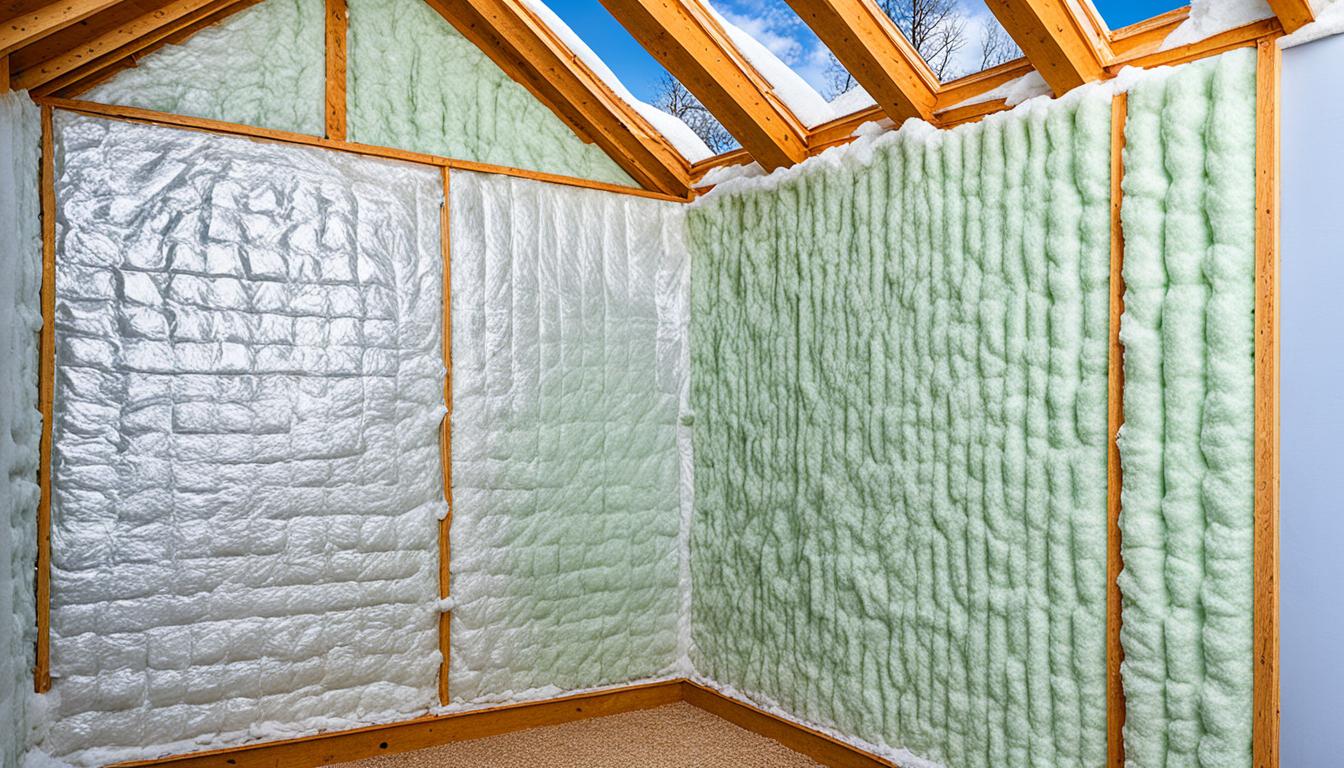How to Figure How Much Insulation I Need For Walls?
Are you curious about making your home more energy-efficient? Figuring out the right insulation for your walls is key to better thermal performance and lower energy bills. But, it can seem overwhelming. This guide will help you understand how to calculate your insulation needs, explore different materials, and make a smart choice.
Key Takeaways
- Understand the importance of proper wall insulation for energy efficiency and comfort.
- Explore the various types of wall insulation materials, including fiberglass, spray foam, and rigid foam boards.
- Learn how to measure your wall cavity dimensions and determine the right insulation R-value.
- Discover online insulation calculators and manual calculation methods to estimate your insulation needs.
- Gain insights into the cost factors associated with wall insulation, including material and installation expenses.
Introduction to Wall Insulation
Proper wall insulation is key for energy efficiency, comfort, and saving on heating and cooling costs. It acts as a barrier, trapping air to prevent heat from moving through the walls. This can greatly affect your energy use and home comfort.

Understanding the Importance of Proper Insulation
Insulation needs to change with the climate and local rules. The main aim is to make your home well-insulated. This helps control heat flow, keeping your home cool in summer and warm in winter. This leads to lower energy bills and a greener lifestyle.
Benefits of Insulating Exterior and Interior Walls
- Improved energy efficiency: Proper insulation cuts down heat transfer, leading to less energy use and lower bills.
- Enhanced comfort: Insulation keeps the indoor temperature steady, making your home more comfortable all year.
- Noise reduction: Insulation can help block sounds, making your home quieter and more peaceful.
- Increased home value: Well-insulated homes are more appealing and can sell for more money.
- Environmental benefits: Using insulation wisely helps reduce energy use, making the planet greener.
Knowing how important proper wall insulation is helps homeowners make smart choices for their homes. It leads to better energy efficiency and more comfort.
Read More: Benefits of Spray Foam Insulation
Factors Affecting Insulation Needs
Choosing the right insulation for your walls depends on several important factors. Knowing about climate zones and regional needs is key for your home's energy use and comfort.
Climate Zones and Regional Requirements
The climate zone where your home is located is a major factor. Different areas have different temperatures, humidity, and weather patterns. These affect how much insulation you need.
For example, homes in cold areas need more insulation to keep warm. In warm areas, you might need more insulation to keep cool.
Local building codes and regulations also play a role. They set minimum R-values, or thermal resistance, for energy efficiency. Knowing your local climate and rules helps you choose the right insulation for your home.
Finding the right balance between climate, local rules, and insulation needs is crucial. This balance helps save energy and lower your bills. By considering these factors, you can make sure your walls are well-insulated. This keeps your home comfortable and energy-efficient.
Types of Wall Insulation Materials
There are many insulation materials for your walls. Each has its benefits and drawbacks. Let's look at fiberglass batts and rolls, spray foam insulation, and rigid foam boards.
Fiberglass Batts and Rolls
Fiberglass batts and rolls are a top pick for insulation. They're made of thin glass fibers and are simple to put in. They help keep your home warm or cool, depending on what you need.
Spray Foam Insulation
Spray foam insulation is great for walls. It starts as a liquid and then expands to fill in gaps. There are two kinds: open-cell and closed-cell spray foam. Each has its strengths in keeping your home insulated and dry.
Rigid Foam Boards
Rigid foam boards, like EPS or XPS, are top-notch insulation. They're solid panels that work well on both outside and inside walls. They're chosen for their strong insulation, lasting long, and keeping air and moisture out.
Choosing the right insulation depends on several things, such as R-value, how easy it is to install, and cost. Knowing what each insulation type offers helps you pick the best one for your home and wallet.
Calculating Wall Cavity Dimensions
To figure out how much insulation you need, first measure the wall cavity dimensions. This means looking at the wall's height, length, and the space and depth of the studs. Knowing these details helps you know how much insulation you should buy.
Measuring Wall Heights and Lengths
Begin by measuring the wall height from the floor to the ceiling. Then, measure the length of each wall from corner to corner. These measurements, along with the wall heights, tell you the total area that needs insulation.
Determining Stud Spacing and Depth
Wall studs are the vertical parts that make up your walls. Their spacing and depth affect how much insulation you'll need. Usually, studs are 16 or 24 inches apart. Use a stud finder or manual measurement to find out how far apart they are in your walls. Also, check the depth of the studs to see how thick the insulation can be.
With these measurements - wall heights, lengths, stud spacing, and depth - you can calculate the wall cavity dimensions accurately. This helps you figure out the right amount of insulation for your home.
Insulation R-Value Explained
Insulating your walls is crucial, and the R-value is key. It measures how well insulation stops heat from moving. This is vital for your home's energy efficiency.
A higher R-value means better insulation. It keeps your home warm in winter and cool in summer. This reduces your energy bills and boosts your home's efficiency.
To figure out the insulation r-value for your walls, think about the insulation type, its thickness, and your local climate. Online tools and apps can help with this. They make sure you get the right R-value for your home's needs.
Knowing about insulation R-value helps you make smart choices. It saves you money on energy and makes your home more comfortable and efficient.
Read More: What is the R-value of closed cell spray foam?
How to Use an Insulation Calculator
Finding the right insulation for your walls can seem hard, but insulation calculators make it easier. These tools help you figure out how much insulation you need. They make sure your home stays cozy and saves energy.
Online Calculators and Apps
Many top brands and home stores have easy-to-use online insulation calculators. They ask for simple info like your wall size, climate, and the R-value you want. Then, they suggest the best insulation type and amount.
There are also mobile apps for insulation planning. These apps let you enter your wall details for quick calculations anywhere.
Manual Calculations for Wall Insulation
- If you like doing things by hand, manual calculations are an option. Measure your wall height, length, and cavity depth. Then, figure out how much insulation you need based on the R-value.
- This method takes more time but gives you a clear picture of what you need. It's a good way to understand your insulation requirements better.
Choosing an online calculator, a mobile app, or a manual method helps you make smart insulation choices. It ensures your home is well-insulated.
How to Figure How Much Insulation I Need for Walls
Finding the right insulation for your walls is key to keeping your home comfy and saving energy. Just follow a few easy steps to figure out how much insulation you need. This depends on your wall size and the weather where you live.
Start by measuring your walls' height and length to find the total area to insulate. Then, think about how deep your walls are and how far apart the studs are. This helps you pick the right thickness for your insulation.
- Measure the wall height and length to calculate the total square footage.
- Determine the depth of your wall cavities and the stud spacing to select the right insulation thickness.
- Consult the recommended R-value for your climate zone to ensure proper thermal performance.
- Use an online insulation calculator or manual formulas to determine the required amount of insulation.
- Factor in any unique features, such as corners, windows, or doors that may require additional insulation.
By carefully calculating your wall insulation needs, you can make your home cozy and save on energy. This makes wall insulation installation more effective.
Estimating Insulation Costs
Installing wall insulation requires knowing the costs involved. These costs depend on the insulation type, project size, and installation difficulty. Options like fiberglass batts and spray foam have different prices. It's key to research and compare to find the best deal for your needs.
Read More: cost of foam insulation in existing walls
Material and Installation Costs
Insulation material prices vary from a few dollars per square foot for basic fiberglass to over $10 for spray foam. Installation also adds costs, with labor often making up a big part of the budget. Things like wall size, access, and special equipment can change the final cost.
Cost Savings from Proper Insulation
The initial cost of insulation might seem steep, but the long-term benefits are huge. Insulated walls cut down on energy use, leading to big savings on bills. This not only saves money but also helps the environment. Plus, well-insulated homes can sell for more, making insulation a smart investment for now and later.
Read More: Cost of Spray Foam Insulation
FAQ
What factors affect the amount of insulation I need for my walls?
The amount of insulation you need depends on the climate, building codes, and wall size. It would help if you also thought about the insulation's R-value. Getting these right helps make your walls energy-efficient.
What are the different types of wall insulation materials?
Common wall insulation types include fiberglass, spray foam, and rigid foam boards. Each has its benefits and drawbacks. It's key to pick the right one for your needs and preferences.
How do I calculate the wall cavity dimensions for insulation?
Measure the wall height, length, and how far apart the studs are. Also, I need to know the depth of the studs. This info helps you figure out how much insulation you need.
What is insulation R-value, and how does it affect my insulation needs?
Insulation R-value shows how well a material stops heat from flowing. A higher R-value means better insulation. It helps you choose the right insulation for your energy goals.
How can I use an insulation calculator to determine my wall insulation needs?
Online tools and apps can help you figure out how much insulation you need. Just enter your wall details, climate, and R-value target. Or, you can do the math yourself with the right info.
How much will it cost to insulate my walls?
Insulation costs vary by type, amount needed, and installation labor. Consider material prices, installation fees, and energy savings to estimate the total cost.




